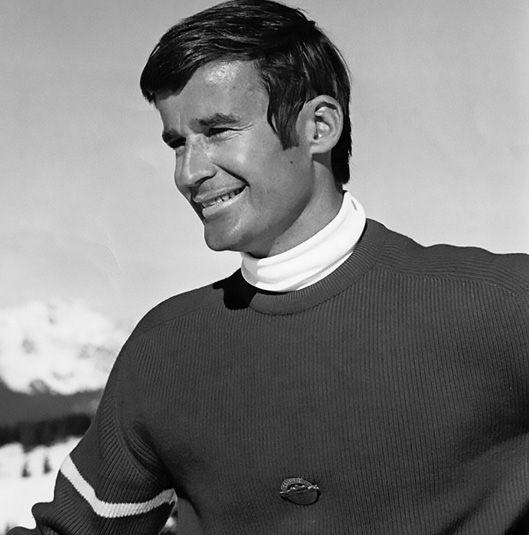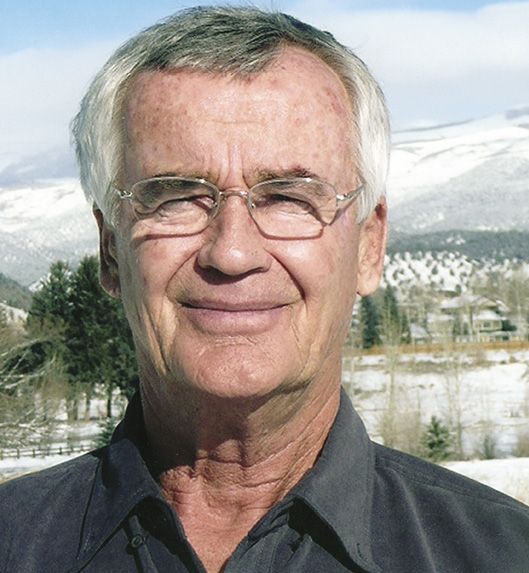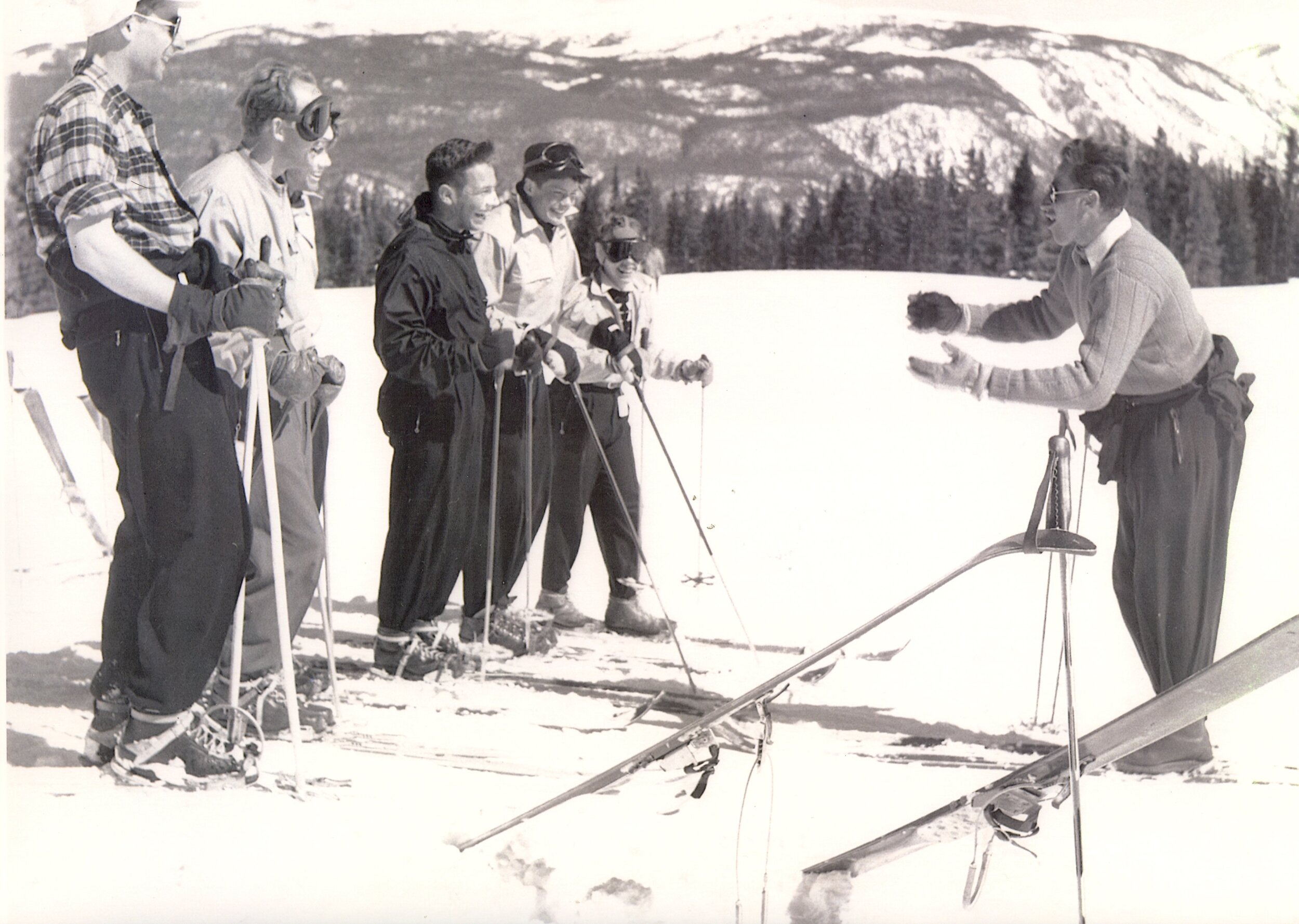SKIING HISTORY
Editor Seth Masia
Managing Editor Greg Ditrinco
Consulting Editor Cindy Hirschfeld
Art Director Edna Baker
Editorial Board
Seth Masia, Chairman
John Allen, Andy Bigford, John Caldwell, Jeremy Davis, Kirby Gilbert, Paul Hooge, Jeff Leich, Bob Soden
Founding Editors
Morten Lund, Glenn Parkinson
To preserve skiing history and to increase awareness of the sport’s heritage
ISHA Founder
Mason Beekley, 1927–2001
ISHA Board of Directors
Rick Moulton, Chairman
Seth Masia, President
Wini Jones, Vice President
Jeff Blumenfeld, Vice President
John McMurtry, Vice President
Bob Soden (Canada), Treasurer
Richard Allen, Skip Beitzel, Michael Calderone, Dick Cutler, Wendolyn Holland, Ken Hugessen (Canada), David Ingemie, Joe Jay Jalbert, Henri Rivers, Charles Sanders, Einar Sunde, Christof Thöny (Austria), Ivan Wagner (Switzerland)
Presidential Circle
Christin Cooper, Billy Kidd, Jean-Claude Killy, Bode Miller, Doug Pfeiffer, Penny Pitou, Nancy Greene Raine, Lindsey Vonn
Executive Director
Janet White
janet@skiinghistory.org
Membership Services
Jamie Coleman
(802) 375-1105
jamie@skiinghistory.org
Corporate Sponsorships
Peter Kirkpatrick
(541) 944-3095
peterk10950@gmail.com
Bimonthly journal and official publication of the International Skiing History Association (ISHA)
Partners: U.S. Ski and Snowboard Hall of Fame | Canadian Ski Museum and Hall of Fame
Alf Engen Ski Museum | North American Snowsports Journalists Association | Swiss Academic Ski Club
Skiing History (USPS No. 16-201, ISSN: 23293659) is published bimonthly by the International Skiing History Association, P.O. Box 1064, Manchester Center, VT 05255.
Periodicals postage paid at Manchester Center, VT and at additional mailing offices. Postmaster: Send address changes to ISHA, P.O. Box 1064, Manchester Center, VT 05255
ISHA is a 501(c)(3) public charity. EIN: 06-1347398
Written permission from the editor is required to reproduce, in any manner, the contents of Skiing History, either in full or in part.
Whatever Happened to Student Centered Teaching?
How ski lessons became fun.
Perhaps because formal ski instruction grew from the experiences of Georg Bilgeri, Matthias Zdarsky and Hannes Schneider in training Austrian troops during World War I, from early on ski teachers were asked to follow a linear, one-size-fits-all program of exercises. Schneider’s Arlberg system was the most influential such progression. National skiing styles—so-called French, Swiss and Austrian techniques—became marketing tools for ski resorts, and instructors proudly taught the characteristic movements that defined those techniques, all in the correct order. To the extent that some instructors found a need to adapt lesson content to individual students, it was left up to them to figure out how to do that. I label this basic level of empathetic teaching style Student-Centered Teaching 1 (SCT 1.0).

My journey as a learner, teacher, instructor and coach started while attending the University of Vienna from 1959 to 1964. My study of the behavioral sciences brought me to the work of Sigmund Freud, B. F. Skinner, Carl Rogers, Abraham Maslow, Maria Montessori and Rudolf Steiner. They taught me to look at teaching through the experience of the student. Given the vast diversity in age, gender, learning and risk-management style and athletic ability, plus the fact that students responded to my teaching in vastly different ways, I made it Job One to customize lessons to the student’s dreams, needs and aspirations. I call this intentional lesson planning SCT 2.0.
(Photo top of page: Klaus Obermeyer teaching in Aspen, around 1959).
Breakthrough at Kitz
I had an epiphany one cold morning at Kitzbühel in 1959. I was teaching a multilingual group of ski-week students. On the second day I showed up with severe laryngitis, rendering me unable to speak. I could teach only using gestures and demos. I used grins and applause as positive reinforcement. In the absence of my voice, the class found its own voices, helping, cheering and teaching one another. Class energy and noise kept rising until we attracted the attention of nearby classes, stuck in their disciplined formations. Not only did we have more fun than any other class that day, but my crew progressed at an unexpected rate. We were able to close the day with an exciting run to the neighboring town of Kirchberg, and a celebratory dinner that formed lifelong friendships.
The experience fundamentally changed how I teach and how I define teacher and student roles, responsibilities and interdependency. To teach effectively, I found, you must park your ego in the locker room, speak less, listen with care, resist the temptation to micromanage the student’s learning with superfluous technical instruction, and trust the student’s innate capabilities. Effective teaching isn’t a one-way command mode of communication, it’s a symmetrical, reciprocal mode. It took me some time to digest this realization and more to formulate a teaching style I now refer to as SCT 3.0: the understanding that learning to optimize learning is an infinite process.
Coming to America
In 1965 I came to Aspen under the admirable and caring directorship of Curt Chase, one of the founders of the Professional Ski Instructors of America. Curt urged his instructors to think about the great international skiing experiences many of our worldly guests brought with them. We could learn from our students as we taught, as long as we listened.
PSIA was in its infancy. Almost all of what we learned came from outside the organization. On the technical side, Georges Joubert’s book Teach Yourself To Ski (translated in 1970 by Aspen’s own Sim Thomas) identified and gave language to skiing actions we had known but had not explained well. On the scientific side, the work of Carl Rogers, Abraham Kaplan, David Kolb, Tim Gallwey and Betty Edwards showed us the functions of left and right brain as they relate to arts and sports. Ron Heifetz of Harvard and Alex Bavelas of Stanford taught us the difference between technical and adaptive solutions, explaining why even the best technical teaching often fails to achieve intended outcomes. Richard Farson’s brilliantly paradoxical observation that “everything we try works” helped focus our thinking toward what works when, and why. It all reinforced my commitment to actively engage students in their learning process, invite the student to drive the content of the lesson and use lesson-inspired language rather than acronyms of locker-room language. I call this level of understanding SCT 4.0.
In 1970, Jerry Muth invited me to the Vail Ski School to become director of training and development, and I took the job in 1971. PSIA, then 10 years old, was maturing and saw a need to synthesize a rational training process for American instructors, and so, that same year, they offered me the same position and function. Vail management allowed me fill both the local and national responsibilities.
To populate the steering committee at PSIA, I was fortunate to find a formidable group of people in Stu Campbell, Juris Vagners, Carl Wilgus, Max Lundberg and Mike Porter, with the PSIA Demo Team as the information conduit to the membership. My principal goals for the next five years were: Simplify language and concepts, Amplify student engagement and Gamify the learning experience. With great collaboration and high energy, the steering committee accomplished the following:
• Within one year we produced our first edition of the American Teaching Methodology (later to become American Teaching System). We saw ATM as a work in progress, to be updated as we learned what worked best.
• In 1974 we launched the first National Ski Instructor’s Academy in Timberline, Oregon.
• In 1976 we introduced the Basic Skills concept, synthesizing the jumble of ski techniques and associated mechanics into just three universal functions: turning, edging and pressure control. 1971 to 1978 were the steering committee’s glory years, as we made great progress both at home and internationally. Our Basic Skills Concept, condensing skills to steering, edging and pressure control, made a worldwide splash.
Aftermath
Starting in 1978 our team began to show ideological cracks when I stretched our committee conversations beyond the technical and biomechanical dimensions, thus pushing the team beyond their main interest and resident expertise. PSIA fired me suddenly and without explanation on a sunny day in Mammoth Mountain in 1980.
But in 1983, PSIA published my book Skiing Right, which summarized my efforts to humanize ski instruction. The title wasn’t meant to be prescriptive (it didn’t claim a single best way to ski), but instead referenced the role of the brain’s right hemisphere in learning.

Thirty years later, a new generation of PSIA thought leaders and D-Team members (Dave Schuiling, Michael Rogan, Josh Fogg and others) developed Learning Connection, a methodology that identifies “People Skills, Teaching Skills and Technical Skills” as its training focus. They introduced it at the 2015 Interski Congress. The latest significant contribution to ski instruction came in 2014 from motor-skills development research by Drs. Gabriele Wulf and Rebecca Leethwaite. Their OPTIMAL concept synthesizes learning and performance-management theory into three simple but most impactful practices: Elevate Expectations addresses the importance of a positive mindset and self-expectations. Externalize Focus: Direct the student’s attention on a peripheral outcome rather than on the internal movements leading to the intended outcome. Autonomy: Provide the student with choices, rather than forcing a singular form of performance on them. The jury is out to what extent PSIA will mainstream OPTIMAL or adopt only its mechanical practice.
The real barometer of PSIA’s teaching effectiveness resides in what the instructor understands as masterful teaching. 
Horst Abraham teaches executive education at the Ross School of Business at the University of Michigan. He holds a double master’s degree in education and behavioral science from the Universities of Vienna and Cologne, and a business degree from the Colorado Business School in Denver. He is a nationally certified mountain guide, ski instructor and ski coach in Austria, France and the United States.
Effective teaching isn’t a one-way command mode of communication, it’s a symmetrical, reciprocal mode.
Table of Contents
WORLD CHAMPIONSHIP ($3,000+)
BerkshireEast/Catamount Mountain Resorts
Gorsuch
Warren and Laurie Miller
Sport Obermeyer
Peak Ski Company
Polartec
CHAMPIONSHIP ($2,000)
Fairbank Group: Bromley, Cranmore, Jiminy Peak
Hickory & Tweed Ski Shop
Rossignol
Snowsports Merchandising Corporation
WORLD CUP ($1,000)
Aspen Skiing Company
Atomic USA
Bogner of America
Boyne Resorts
Dale of Norway
Darn Tough Vermont
Dynastar/Lange/Look
Gordini USA Inc/Kombi LTD
Head Wintersports
Intuition Sports
Mammoth Mountain
Marker/Völkl USA
National Ski Areas Association
North Carolina Ski Areas Association
Oppenheimer & Co. Inc.
Outdoor Retailer
Salomon
Ski Area Management
Ski Country Sports
Sports Specialists Ltd
Sugar Mountain Resort
Sun Valley Resort
Vintage Ski World
World Cup Supply
GOLD MEDAL ($700)
Larson's Ski & Sports
McWhorter Driscoll LLC
Race Place/Beast Tuning Tools
The Ski Company (Rochester NY)
Thule
World Pro Ski Tour/Jon J. Franklin
SILVER MEDAL ($500)
Alta Ski Area
Boden Architecture PLLC
Dalbello Sports
Deer Valley
EcoSign Mountain Resort Planners
Elan
Fera International
Fischer
Holiday Valley Resort
Hotronic USA/Wintersteiger
Leki
Masterfit Enterprises
Metropolitan New York Ski Council
Mt. Bachelor
New Jersey Ski & Snowboard Council
Nils
Russell Mace Vacation Homes
SchoellerTextil
Scott Sports
Seirus Innovations
SeniorsSkiing.com
Ski Utah
Snowbird Ski & Summer Resort
Steamboat Ski & Resort Corp
Sundance Mountain Resort
Swiss Academic Ski Club
Tecnica Group USA
Timberline Lodge and Ski Area
Trapp Family Lodge
Wendolyn Holland
Western Winter Sports Reps Association


